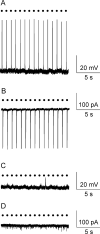Direct projections from hypothalamic orexin neurons to brainstem cardiac vagal neurons
- PMID: 27693474
- PMCID: PMC5118111
- DOI: 10.1016/j.neuroscience.2016.09.038
Direct projections from hypothalamic orexin neurons to brainstem cardiac vagal neurons
Abstract
Orexin neurons are known to augment the sympathetic control of cardiovascular function, however the role of orexin neurons in parasympathetic cardiac regulation remains unclear. To test the hypothesis that orexin neurons contribute to parasympathetic control we selectively expressed channelrhodopsin-2 (ChR2) in orexin neurons in orexin-Cre transgenic rats and examined postsynaptic currents in cardiac vagal neurons (CVNs) in the dorsal motor nucleus of the vagus (DMV). Simultaneous photostimulation and recording in ChR2-expressing orexin neurons in the lateral hypothalamus resulted in reliable action potential firing as well as large whole-cell currents suggesting a strong expression of ChR2 and reliable optogenetic excitation. Photostimulation of ChR2-expressing fibers in the DMV elicited short-latency (ranging from 3.2ms to 8.5ms) postsynaptic currents in 16 out of 44 CVNs tested. These responses were heterogeneous and included excitatory glutamatergic (63%) and inhibitory GABAergic (37%) postsynaptic currents. The results from this study suggest different sub-population of orexin neurons may exert diverse influences on brainstem CVNs and therefore may play distinct functional roles in parasympathetic control of the heart.
Keywords: brainstem; cardiac; neurons; optogenetic; orexin; parasympathetic.
Copyright © 2016 IBRO. Published by Elsevier Ltd. All rights reserved.
Figures




References
-
- Antunes VR, Brailoiu GC, Kwok EH, Scruggs P, Dun NJ. Orexins/hypocretins excite rat sympathetic preganglionic neurons in vivo and in vitro. American journal of physiology Regulatory, integrative and comparative physiology. 2001;281:R1801–1807. - PubMed
-
- Apergis-Schoute J, Iordanidou P, Faure C, Jego S, Schone C, Aitta-Aho T, Adamantidis A, Burdakov D. Optogenetic evidence for inhibitory signaling from orexin to MCH neurons via local microcircuits. The Journal of neuroscience : the official journal of the Society for Neuroscience. 2015;35:5435–5441. - PMC - PubMed
-
- Bouairi E, Neff R, Evans C, Gold A, Andresen MC, Mendelowitz D. Respiratory sinus arrhythmia in freely moving and anesthetized rats. J Appl Physiol (1985) 2004;97:1431–1436. - PubMed
MeSH terms
Substances
Grants and funding
LinkOut - more resources
Full Text Sources
Other Literature Sources

